https://twitter.com/the_Hotstar
“Any Age of Expansion has strong trends towards rationalism because of the need to make decisions between alternative actions in a period when status is being disrupted and social atomism is prevalent because of expansion. Nevertheless, science (which is, of course, entirely different from rationalism because of its faith in observation) usually flourishes in an Age of Expansion and is killed off by irrationalism in the following Age of Conflict. In Classical antiquity this pattern was not followed. There, rationalism was very strong in the Age of Expansion and began to attack science while this period was still in progress. In the following period, science was destroyed, not by irrationalism, but by rationalism. The reason for this aberration in the pattern lies in the fact that in Classical antiquity rationalism became allied with oligarchy and shared in its victory over both science and democracy.”
there's this very old philosophical conspiracy to convince people, first that reality is absolute, and second, that the absolute truth to reality can only be discovered rationally through numbers. its aim is to replace intuitive understanding developed through sensory experiences of the world with authoritative knowledge dictated by data and statistics.
if it can be accepted by people, in their minds, that reality can be perfectly expressed in numbers, then reality can be completely controlled by whichever authority or institution controls the arbitrary process of converting it into numbers.
everyone has a pair of eyes - observation is decentralised, can't be controlled.
rationality, or the mind's eye, can be centralised through data, data can be controlled.
if everyone comes to view reality through a single eye of data, that organ will gain absolute power over society as if it were the parts of one single human body.
this philosophy is pythagorean rationalism and it was introduced into western philosophy around 500 b.c by the pythagorean brotherhood, whose proverb reasoned, “all things are assimilated to numbers.” as aristotle explains in his work 'the metaphysics':
At the same time, however, and even earlier the so-called Pythagoreans applied themselves to mathematics, and were the first to develop this science; and through studying it they came to believe that its principles are the principles of everything.And since numbers are by nature first among these principles, and they fancied that they could detect in numbers, to a greater extent than in fire and earth and water, many analogues of what is and comes into being—such and such a property of number being justice, and such and such soul or mind , another opportunity , and similarly, more or less, with all the rest—and since they saw further that the properties and ratios of the musical scales are based on numbers, and since it seemed clear that all other things have their whole nature modelled upon numbers, and that numbers are the ultimate things in the whole physical universe, they assumed the elements of numbers to be the elements of everything, and the whole universe to be a proportion1 or number. Whatever analogues to the processes and parts of the heavens and to the whole order of the universe they could exhibit in numbers and proportions, these they collected and correlated; and if there was any deficiency anywhere, they made haste to supply it, in order to make their system a connected whole.
they believed everything was made out of numbers and all numbers descended from 1, or ‘the one’, called the monad, believed to be the first metaphysical thing from which all other things are created. the symbol of the monad was a circle with a dot in the center, like an eye.

the pythagorean monad
from the monad came the dyad, the two. from the dyad came the triad, the three, and so forth.
the pythagoreans visualised this creation process as geometry, with the dyad descending from beneath the monad as two particles or points to create trianglar form. this triangle became a sacred symbol of the brotherhood, and the numbers which could form triangular geometry became sacred numbers. the number ten took on a particular significance in forming a ten point triangle the pythagoreans called the tetractys. the points of the tectractys represented the properties of reality. the first dot(monad) representing position, the two dots below it(dyad) - extension, three dots - surface, and the four dots at the base - three-dimensional space. but at the top of each triangle was always the monad. the point of creation for all else below it.

so here we have, around 500 b.c, the sacred form of a triangle called the tectractys with its upper most point symbolised by a circle with a dot in its center called the monad. and this symbolised the properties of geometry, or a world made up of perfectly whole numbers.
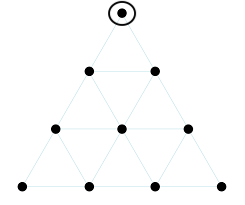
the tetractys
pythagorean rationalism is the same philosophical concept of virtual reality introduced into popular culture by the 1999 film, the matrix. the pythagoreans believed(or so they claimed) that we lived inside the matrix, a virtual reality of forms constructed entirely of numbers. if one could discover the “nature” of these numbers behind this “virtual” reality, then reality could be controlled through mathematics. this is the plot of the matrix. neo lives in a virtual reality of forms and comes to see these forms for what they truely are, numbers, giving him more and more control over them. an iconic scene in the film is a POV shot of neo coming to this revelation and experiencing the reality of the matrix purely through numbers.

in the film morpheus guides neo to this revelation. in greek myth pythagoras was intiated in the teachings of the phrygian prophet orpheus.
if you can understand the matrix then you can understand pythagorean rationalism in two tenets:
1) the forms of reality aren’t real but virtual, meaning you can’t trust your senses to discover truth.
2) whatever truth lies hidden behind these virtual forms can be perfectly expressed in numbers, meaning reality is perfectly rational and can be discovered using a rational method like mathematics.
it's important to note that this isn't just a belief in rationalism or objectivity, but one which excludes the need for any observational validation of the conclusions it reaches. a kind of fascist mathematics that can define truth through pure theory it never has to prove observationally in the real world. instead it creates its own observational evidence using geometric models of reality out of numbers. it's suggesting, “do not trust what you sense of reality as true, trust what our numbers add up to.”
for instance, you may observe with your senses a building collapse in a free fall motion known to be how buildings collapse due to a controlled demolition.
however, if this sensory observation was at odds with a desire for it to have collapsed inadvertently, say due to fire, then using the power of pythagorean rationalism a data model could be created to show, using numbers, that what had been observed in reality wasn’t actually true. that there was no controlled demolition. that in truth the building had collapsed in a free fall motion due to progressive fires. something never before observed in reality and only just discovered, for the first time ever, using numbers.
now the reason why pythagorean rationalism has been a conspiracy since from almost the beginning, as opposed to an earnest outlook on the nature of reality is this. not long after his philosophy became doctrinaire, a student of pythagoras named hippasus proved using rational means that reality was not in fact rational, but irrational, through the discovery of irrational numbers.
hippasus had discovered that if you made a line that was the length of a circle's circumference and another line that was the length of that same circle's diameter, there was no unit of measurement which would fit into both with nothing left over. meaning there was no number to express the ratio between a circle's circumference and its diameter. so an arbitrary symbol had to be used instead of a precise number - π
darren aronofnsky’s Pi is a film about the rationalist inability to cope with the reality of irrational numbers, while also touching on the link between this and the sacred numerology of hebrew mysticism. the protagonist is trying to solve the rationalist problem of irrational infinity numbers using computational power. this hopeless endeavour drives them to insanity and they eventually reconcile this mania by drilling a hole in their head, which allows them to accept not being able to know the unknowable and brings them peace of mind.
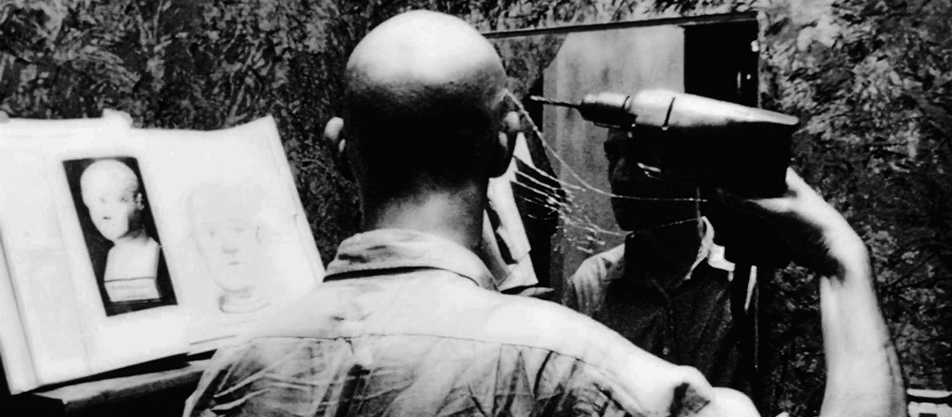
the pythagoreans on the other hand ignored this contradiction in their philosophy, and according to some sources killed hippasus over his discovery. instead they continued to claim that reality was absolute and rational. since their motive for doing so was ulterior to truth, their philosophy became a conspiratorial one.
see, the pythagorean brotherhood had also been the intellectual wing of dorian oligarchy, who had adopted their philosophy to legitimise the totalitarian regimes of their greek city states, the most prominent of which - sparta and thebes, had been in perpetual civil war to overthrow democratic city states like athens. as Carroll Quigley writes:
“Pythagoras himself was the founder of an international oligarchic conspiracy, the Pythagorean Brotherhood, which operated out of Croton, in southern Italy, until it was forced to flee from that city by a democratic uprising about 510 B.C. Thereafter this organization centered in Thebes in Boeotia. In international affairs it operated in support of the oligarchic states and in opposition to the democratic states, like Athens. In intellectual matters it attacked Ionian Science, the sophists, the philosophical nominalists, and the upholders of democracy and of human equality. ”
the agenda of the dorian oligarchs(Spartans) had been to freeze greek culture into stasis by arranging it, by force, into rigid highly controllable orders which prevented change, thus fixing the class structure of society in place with them at the top. since that time it has been an agenda, or even tradition, for western oligarchs to perpetuate pythagorean rationalism in various forms, by way of plato, on through to its manifestation in the totalitarian utopias of the enlightenment, to most recently 'the science' of the modern era. quigley makes an interesting observation about how rationalism, not just irrationalism, can be used to attack science aswell:
“Any Age of Expansion has strong trends towards rationalism because of the need to make decisions between alternative actions in a period when status is being disrupted and social atomism is prevalent because of expansion. Nevertheless, science (which is, of course, entirely different from rationalism because of its faith in observation) usually flourishes in an Age of Expansion and is killed off by irrationalism in the following Age of Conflict. In Classical antiquity this pattern was not followed. There, rationalism was very strong in the Age of Expansion and began to attack science while this period was still in progress. In the following period, science was destroyed, not by irrationalism, but by rationalism. The reason for this aberration in the pattern lies in the fact that in Classical antiquity rationalism became allied with oligarchy and shared in its victory over both science and democracy.”
the reason why oligarchs love pythagorean rationalism is because they hate change. they hate change because established power structures are threatened by anything new they don't control. pythagorean rationalism posits that the reality of change we see is actually absolute, knowable, and unchanging, but only discoverable by a select few. in this way an unchanging reality can be crafted and controlled, but most importantly, legitimised and accepted by all, through a process of 'discovering' the best absolute form of everything, including the best ruling class. do you see?
conversely, the democratic tradition has been based on the view that reality is relative because it’s always changing, and that since the truth of nature cannot be known for sure, a diversity of beliefs should be tolerated as no single one could ever be justified, by natural right, in wiping all the others out.
these two differing philosophical outlooks, that of an absolute unchanging reality vs a relative one of flux, caused a rift in the political system of ancient greece which resulted in perpetual civil war between democratic and oligarchic city states.
during this time, and after the pythagorean brotherhood had ceased as a formal organisation, their doctrine was adopted and canonised into western philosophy by plato, the nephew of a dorian oligarch named charmides who had led a group called “the thirty“ in a coup which overthrew athenian democracy around 400 B.C. after this dorian junta was dispelled the athenian democrates executed plato’s teacher socrates, whom plato martyrised in a work called 'phaedo'. everything known of socrates is through plato and a select few others also allied to the dorian oligarchs, such as xenophon. so really, the primary source of western philosophy as it’s taught in standardised accounts is plato, an oligarch propagandist whose political theories were based on the tenets of pythagorean rationalism.
with his theory of perfect forms plato had rehashed the pythagorean outlook of an absolute unchanging reality that cannot be sensed in the physical world. that the forms of the world we sense are imperfect but behind them lies a world of perfect ones. for there to be a perfect something there must be any number of inferior forms that are imperfect, the difference between them being objective and absolute. plato also reiterates this with his allegory of the cave. that we only see the shadow of reality projected on a cave wall.
with his most famous work plato put these tenets to work as the philosophy basis, or justification for, a society called the republic. a form of government by means ever intended to mean democratic.
plato’s republic was to be totalitarian. this term often is confused with authoritarian. while authoritarian means are the only real way of achieving totalitarian ends, a totalitarian state in theory is quite literally the oppose of an authoritarian one. for instance, orwell’s 1984 is authoritarian but huxley’s brave new world is totalitarian. by totalitarian is meant, all social identities from which one forms their personality, such as the person themselves individually, or socially as a member of a family or community, are abolished and replaced with a single, non-diverse, uniform identity they adopt at the state level. the identity of a citizen. so a totalitarian society is one in which the majority of people identify as part of a state and as citizens, more than they do the various social units below it, such as a member of a family or community. the difference between these social layers is that an individual has interpersonal relationships with their family and community they do not share with other citizens in society, who are strangers. in a totalitarian society people place loyalty to their state over loyalty to their family. there are reasons why this doesn’t work which i won’t get into, but it basically has to do with the fact that people fulfil their social needs through interpersonal relationships they don't have as citizens. theoretically though, if everyone had the same personality there would be no distinction between a member of your family and another citizen you've never met. and that is the ultimate goal of totalitarianism. to make everyone quite literally the same. as plato points out:
“’The best way to reach agreement about that will be to ask ourselves what we regard as the greatest social good, the objective of the law-giver’s activity, and what as the greatest social evil; and then to consider whether the proposals we have just outlined bear the imprint of the good and not of the evil’, ‘Yes, that is the way’, ‘is there anything worse for a state than to be split and fragmented, or anything better than cohesion and unity?’, ‘No.’, ‘And is not cohesion the result of the common feelings of pleasure and pain which you get when all members of a society are glad or sorry at the same successes and failures?’ ‘Certainly.’, ’but cohesion is dissolved when feelings differ between individuals, and the same events, whether of public or individual concern, delight some and dismay others.’, ‘Of course.’, ‘And doesn’t this happen when the members of society no longer agree in their use of the words “mine” and “not mine”, “somebody else’s” and “not somebody else’s?”, ’That is very true’, ‘So the best-ordered state is one in which as many people as possible use the words “mine” and “not mine” in the same sense of the same things.’, ‘Much the best’ ”
this totalitarian society was to be stratified into two tiers, a majority of producers governed by a minority of guardian enforcing laws designed to abolish everything outside of the citizen identity, particularly the family unit.
“Then don’t you agree that, as i say, there further arrangements will make them even truer Guardians than before? They will prevent the dissension that starts when different people call different things their own, when each carts off to his own private house anything he can lay hands on for himself, and when each has his own wife and children, his own private joys and sorrows; for our citizens, whose interests are identical and whose efforts are all directed so far as is possible towards the same end, feel all their joys and sorrows together.”
from the guardian class was to emerge an even smaller third tier of rulers who would make strategic decisions for the whole of society, an oligarchy of philosopher kings. this oligarchy of rulers was to be brought about through selective breeding and practises of infanticide within the guardian class. this theory of a biologically superior master race made plato the first true eugenicist in recorded history.
“We must, if we are to be consistent, and if we’re to have a real pedigree herd, mate the best of our men with the best of our women as often as possible, and the inferior men with the inferior women as seldom as possible, and bring up only the offspring of the best. And no one but the Rulers must know what is happening, if we are to avoid dissension in our Guardian herd.”
. . . .
“‘These officers will take the children of the better Guardians to a nursery and put them in charge of nurses living in a separate part of the city: the children of the inferior Guardians, and any defective offspring of the others, will be quietly and secretly disposed of.’, ’They must be if we are to keep our Guardian stock pure,’ “
because, according to plato, the class of philosopher kings would be biologically superior, they would be objectively best suited to make decisions on behalf of all others and would be justified in any decision they made by natural right. including the use of deceit for the greater good, which plato describes as a type of medicine.
“ ‘And surely we must value truthfulness highly. For if we were right when we said just now that falsehood is no use to the gods and only useful to men as a kind of medicine, it’s clearly a kind of medicine that should be entrusted to doctors and not to laymen’, ‘Clearly.’, ‘It will be for the rulers of our city, then, if anyone, to use falsehood in dealing with citizens or enemy for the good of the State; no one else must do so. And if any citizen lies to our rulers, we shall regard it as a still graver offence than it is for a patient to lie to his doctor’. . .”
the use of deceit is found at length throughout plato's republic and is known as plato’s “noble lie”, or the rationalisation that doing something bad to achieve something good is actually doing good. this is greater good logic, or quantitative ethics. quantify the bad and good, if the good is greater than the bad then the act is good.
this is probably one of the most pernicious rationalisations in all of human thought because it allows for the actualisation of knowingly doing bad in the real world through theoretically doing good in ones own mind, and through-out history has been a mode of ends-based thinking more common amongst those who have committed its greatest atrocities than greatest goods. while people can control their own actions, they only think they can control the outcomes of them. hitler's plans of a thousand year reich allowed him to rationalise his actions in the present. according to greater good logic, if hitler had acheived his thousand year reich, hitler would've done nothing wrong.
in a section dealing with how his philosopher kings should rule, plato lists five mathematical studies they should be proficient in - arithmetic, plane geometry, solid geometry, astronomy, and harmonics; and grants them absolute power with these through contending truth can only be found by converting reality into numbers, thus allowing those who control numbers to monopolise truth by denying ‘common sense’.
“ ‘What is at issue is the conversion of the mind from a kind of twilight to the true day, that climb up into reality which we shall say is true philosophy.’, ‘Yes of course’, ‘So we must try to find out what sort of studies have this effect.’, ‘We must’, ‘Well Glaucon.’ I asked, ‘what should men study if their minds are to be drawn from the world of change to reality?’ ”
“ ‘For example, there is one thing that all occupations, practical, intellectual, or scientific, make use of - one of the first things we must all learn’, ‘What’, ‘Something quite ordinary - to tell the difference between one, two and three; in a word, to count and calculate. Is it not true that every practical or scientific activity must be able to do that?’, ”
“‘ I wonder, then,’ I asked, ‘if you would agree with me about this branch of study’, ‘In what way?’, ‘That it is probably one of the subjects we are looking for, which naturally leads to thought, though no one makes proper use of its power to draw men to reality?’ ”
“ ‘And so they should be included among the studies we are looking for. Soliders must study them so that they can organize their armies, and philosophers so that they can, as they must, escape from this transient world to reality; otherwise they will never be able to calculate’ ”
“ ‘As we have just said, it draws the mind upwards and forces it to argue about numbers in themselves, and will not be put off by attempts to confine the argument to collections of visible or tangible objects. You must know how the experts in the subject, if one tries to argue that the unit is divisible, won’t have it, but make you look absurd by multipling it if you try to divide it, to make sure that their unit is never shown to contain a multiplicity of parts’.”
so around 400 b.c a book is written by a greek oligarch about the construction of a totalitarian society ruled by a biologically superior master race who control reality through numbers. and this becomes the most canonised book on political theory from the time and place we attribute the birthplace of western democracy. it must be because the blueprint for society plato laid out had been favoured by those with the means to print, publish, and keep libraries of books, and control the perpetuation of knowledge. from the ciceros of rome to the bertelsmann publishing cartel of the present, from whom i have purchased my own copy. a big reason for its survival was its revival during the renaissance by the most powerful banking family in europe, the medici family.
around 1450 cosimo de medici amassed a large collection of greek texts and had all of plato’s works translated into latin by an italian scholar named marsilio ficino, who medici appointed head of an academy he established in florence as an incubator for pythagorean rationalism under what was called neoplatonism. which is around the time we start to see the pythagorean tectractys and other mysterious symbols work their way into the artworks patronised by the medici family.
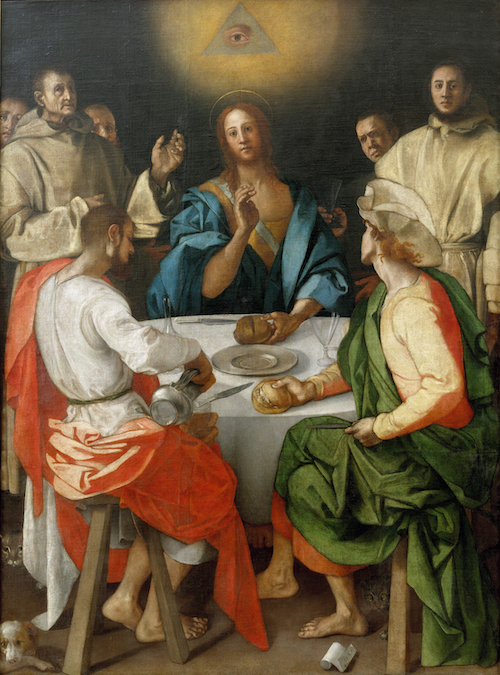
supper at emmaus, pontormo, 1525
the term 'neoplatonism' actually predates the nenaissance as the works of plato had been studied by occult sects at the library of alexandria in the second century b.c and after that by a sage called apollonius of tyana in the first century a.d, and then by kabbalist jews in the middle ages who believed pythagoras had been a student of moses. this spaghetti intersection of history had led to superstitious intrigue into the true origins of the pythagorean brotherhood given the impact their teachings had on philsophical thought, and through it politcal theory.
cosimo de medici had got his hands on a bunch of occult manuscripts called the ‘corpus hermeticum’, supposedly written by a figure named hemes trismegistus before plato, which traced the origins of pythagorean rationalism back to ancient egypt. these manuscripts became the doctrine of a widely popularised sect of occult theory known as hermeticism, though medici’s scholars had seemingly made a ‘radical dating error’.
“A large collection of writings containing ancient lore was received from Macedonia by Cosimo de Medici, translated from Greek by Ficino in 1463, and printed in fifteen editions before 1500. It took the form of dialogues with the Egyptian god Thoth, and seemed to come from the same corpus of texts as other fragmentary dialogues long known to medieval scholars. It was, accordingly, also attributed to ‘Hermes Trismegistus.’ The hermetic corpus ran through many editions until 1614 when a treatise by Isaac Casaubon showed it had been compiled in the post-Christian era. On this basis we are told that Renaissance scholars made a ‘radical error in dating.’ No doubt they had. A neo-Platonic, post-Christian compilation had been mistaken for a work which preceded and influenced Plato. ”
here things start to get confused. during the renaissance pythagorean rationalism had been revived by the medicis, both as a superstitious occult religion and a rational political theory. by the time of the enlightenment, statesmen advocating for rational forms of government by day would retreat to caves and perform bizarre rituals by night.
modernised forms of plato’s republic became popularised in a series of totalitarian utopias, most notably by thomas more’s utopia written in 1516, followed by thomas hobbes leviathan in 1651, and finally jean-jacques rousseau’s social contract in 1762. these three works more or less embodied the evolution in political theory through the enlightenment in the lead up to the revolutionary period. these works were predominantly concerned with identifying the greatest common good to which each individual within a society could be justifiably subjected through despotism. so basically, the justification for using unpleasent means - despotism, to achieve pleasent ends - utopia.
thomas more’s utopia outlined the laws and social customs of a fictional proto-communist island society in which no currency of exchange existed as all property was commonly owned. this had been achieved through the utility of a societal outlook which valued needs over desires instilled in people through social norms which encouraged them to desire their needs. rather than reject pleasure seeking behavior as bad, more's utopian outlook directed it towards health through the belief that health was the greatest bodily pleasure, and thus health was the greatest good. health as the greatest good was justified as a natural law through more's reasoning which pointed to the sensory pleasures experienced from natural bodily functions which replenish health, such as eating and drinking; and those which expel excesses built up within the body that diminish it, such as peeing, defecating, and vomiting. unhealthy pleasurable behaviour more dismissed as unnatural and rather a function of behavior based on a false perception of human nature, as opposed to a result of it. in simple terms more's philosophy for the greatest good was this:
human nature is good
human nature is pleasure seeking
this means pleasure is good
the greatest pleasure is health
which means the greatest good is health
this is more or less known as the humanist outlook. however, in More’s utopia this humanist outlook was totalitarian in that it was applied at the state, rather than individual level. taking the aggregate of individuals within a society and treating them all as if they were quite literally, one single organism, so that the greatest good becomes not what is best for one's health, but public health.
this totalitarian view of society as a monolithic organism made up of tiny little individual bodies was further popularised in the following century by thomas hobbes in his work leviathan. which quite literally illustrated this concept on its cover.
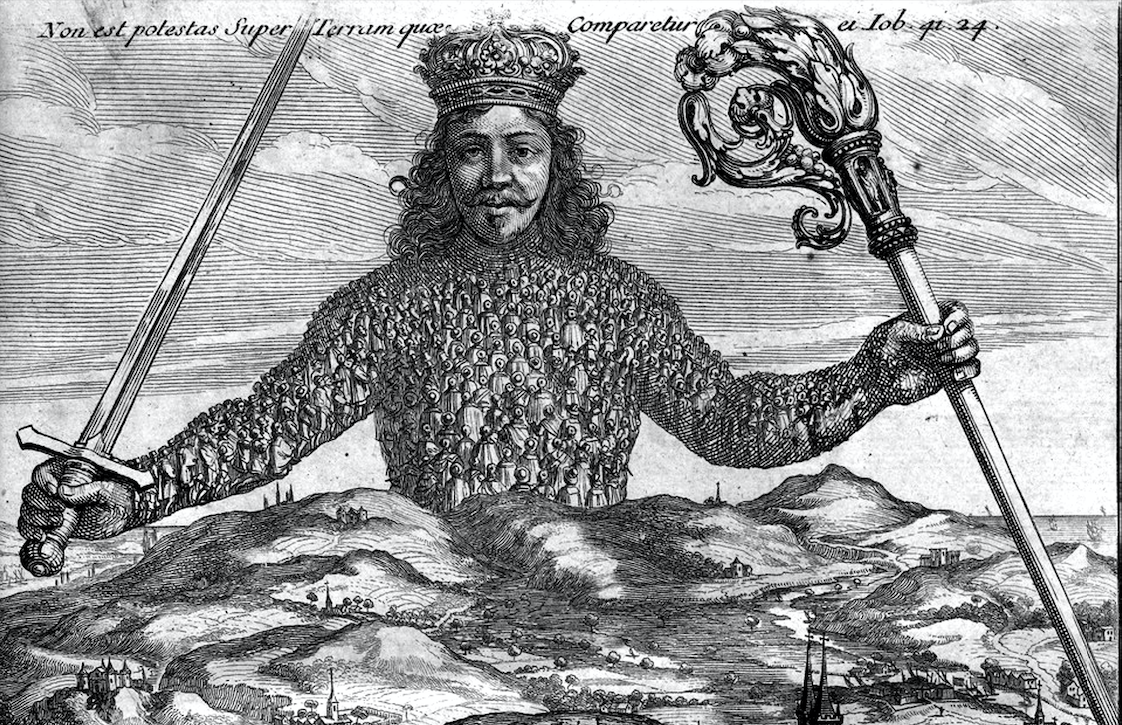
the hobbesian outlook was a little more dire than mores. hobbes rejected the greater good justification more had goien as he thought no one would agree on what the greatest good was. rather, hobbes justification rested on preventing the greater evil, on which he thought more would agree on. the prevention of violent death. hobbes’ greater good justification was this:
nature is cruel and unforgiving
so human nature is cruel and unforgiving
because of this, it's in all our best interests to protect ourselves from our own nature
this is best achieved through strong law & order of a single authority with absolute power.
thus everyone has an obligation to obey this authority unconditionally as regardless of its actions it would be preferable to a society without it.
though hobbes never coined the term himself, his theory of an implicit contract, or obligation, subjecting citizens to the unconditional power of an authority became known as the social contract, which became popularised by rousseau in the next century.
rousseau took hobbes' concept of a social contract but reverted its justification back to more's outlook that human nature was good, and justified totalitarianism on the more sound basis that human nature was collaborative and communal as opposed to competitive and individual. he based this on the obvious observation that before tribes of humans started killing eachother over resources, they had to have first collaboratively formed into the tribes themselves for survival. since one preempted the other, human collaboration must have been more a function of human nature and competition of human behavior.
however, instead of addressing the actual issue of how to scale communal human nature within small groups to large ones, rousseau expanded upon hobbes notion of a social contract. he assumed the social pressures which compel us to conform our behavior within small groups to fulfill our social needs, could just be scaled and used to ostracize individuals who did not conform as citizens. unlike plato, rousseau did not go into the unpleasant details of how this would be achieved.
rousseau's solution was to incorporate every individual into a body corporate he called the sovereign(hobbes’ leviathon), with whom each implicitly sign a contract with at birth granting it absolute power over them. the sovereign would then use this power arbitrarily for the greater good, as if it didn’t the contract would be void. and so individuals have been voiding it ever since.
the social contract became the preeminent political theory leading into the french revolution, but more was at play behind the scenes amongst groups trying to institutie it.
the pythagorean teachings of sacred numerology and geometry, by way of plato, had taken on dark superstitions within the library of alexandria and became twisted into an occult sect known as gnosticism. the gnostics knew the christian doctrine had been developed as a control mechanism of moral behavior, which it was. and because of this came to view its moral tenets as shackles of moral enslavement upon individual liberty, which they were. which led some to conclude that to liberate themselves from this enslavement was to violate these moral tenets. which it certainly wasn't. and from this came the idea of gnossis, which was achieving freedom from moral obligation. extremist sects of gnosticism eventually carried this line of thought to its most logical conclusion. that the highest form of liberation was to be found in the most vile and extreme violations of morality. thus begun a tacit and twisted occult tradition of rape, murder, and torture, the victims of which had to become more and more innocent to make the acts of moral violations more extreme, or 'liberating'.
this extremist outlook can be found in the practises of 18th century aristocrats known as libertines, who formed debauched social clubs dedicated to vice. the most famous of these were the hellfire clubs of francis dashwood in england, while the most famous libertine was a french aristocrat named donatien alphonse françois, better know as Marquis de sade, from whose name came the term sadism to mean, taking pleasure in another's pain. as de sade writes, “Now we come to the crux of my philosophy: if the taking of pleasure is enhanced by the criminal character of the circumstances -- if, indeed, the pleasure taken is directly proportionate to the severity of the crime involved --, then is it not criminality itself which is pleasurable, and the seemingly pleasure-producing act nothing more than the instrument of its realization?”
this sadist doctrine perpetuated forward into the victorian era as a high society tradition which became the subject of a 1885 exposé by british journalist william f. stead in a four part series called the maiden tribute of modern babylon covered in this article: https://thehotstar.net/mythofvice.html
stead inferred the origin of this kind of organised vice amongst elites was to be found in a maix of canaanite and minoan traditions, per reference in his title and drawing upon constant analogies to the cretan myth of the minotaur.
strangely enough, one can actually trace to some extent, a cultural legacy of high society vice as a tacit western tradition, dating back to the greek mystery cults and the formation of their rituals abstracted from pagan religious practises.
what is entered into now, is very confused and uncertain and draws upon mythological patterns and themes somewhat supported by archaeological findings. no doubt some details given are bound to be incorrect. this isn’t something which can be covered factually, only attempted intuitively, as the only way to make an attempt at a meaningful explanation for why we find such an intersection between elite society, rationalist political agendas, and irrational occult superstitions.
this mixture seems to originate in the fact that the pythagorean brotherhood wasn’t a scholarly society of mathematicians, but rather a religious cult of ones. their teachings hadn’t just influenced the political theorists like more, hobbes, and rousseau by way of plato, but also fucking manics like marquis de sade. as burgo partridge writes of this figurehead libertine of the enlightenment in his history of orgies:
“He became fascinated, like Casanova with cabalistic pyramids, referring the numerology, in some involved way to the number of strokes given and received at his flagellatory orgies”
de sade had owned a bookstore in the palais-royal, a royal estate located in central paris with a large garden enveloped by a promenade of private cafes. the estate belonged to louis philippe II, the duke of orleans and cousin to the king louis XVI, who had cultivated it into a playground for french libertines. de sade had been friends with the duke of orleans’s private secretary, a man named choderlos de laclos, who like de sade had been one of many literary pornographers to emerge from that scene.
“The Palais-Royal was the center in Paris not just of high politics and high ideals, but also low pleasure. Along with the ‘political effervescence’ fostered by ‘agitators whose mysterious existence seems more appropriate for a novel than reality’ appeared raucous publications that mixed politics and pornography.
[further down]
The new personal secretary he(duke of orleans) brought to the Palais in 1988, Choderlos de Laclos, was the author of Les Liaisons Dangereuses and a pioneer of the liberated pornography that flourished during the revolutionary era. Laclos’s friend, the Marquis de Sade, opened a bookstore in the Palais during the turmoil to sell his dark masterpieces; every form of sexual gratification that he described was available in the cafes and apartments of the Palais complex.
[further down]
Cafes were the heart and soul of the Palais-Royal. About two dozen ringed the Palais-Royal and beckoned strollers from the gardens into the arcaded pleasure spots which were—literally as well as figuratively—the underground of Paris. Like the Cirque in the middle of the gardens (five-eighths of which was dug out below ground level), the cafes were mostly underground. Some of the most important names— Cafe de Caveau, Cafe des Aveugles, and Cafe du Sauvage—suggest the fetid air, mysterious darkness, and indulgent abandon that characterized these subterranean retreats. The Cafe des Aveugles offered twenty separate ‘caves’ for the sexual and narcotic delectations of its customers, who usually descended there after lighter, alcoholic preliminaries at the Cafe Italien directly above.”
this same subterranean cafe culture of palais-royal had also been observed across the english channel within the nine chamber cave system francis dashwood famously bore beneath a chapel on a hill.
the floorplans of the palais-royal are not unlike those made by archeologists of the labyrinthian ruins of the palace of knossos in crete, which are dated from around 1500-1000 b.c. the trend of hedge mazes found in aristocratic gardens during this period also lends itself to such a comparison.

palais royal

palace of knossos
the palace of knossos in crete is thought to be the origin of the labyrinth described in the myth of the Minotaur on account of its maze-like design and linear b tablets(ancient writing dated around 1400 b.c) discovered in crete and its surrounding regions on mainland greece. tablets found in knossos referenced a goddess(perhaps a a universal term) named potnia of the labyrinth:
A Linear B tablet from Knossos listing religious offerings of jars of honey reads as follows: KN Gg(1) 702
.1 pa-si-te-o-i / me-ri *209VAS 1
.2 da-pu2-ri-to-jo , / po-ti-ni-ja ‘me-ri’ *209VAS 1
The first line can be read as pansi theoihi meli JAR 1 ‘to all the gods: honey: 1 jar’: hence this is clearly a record of religious offerings. On the second line, po-ti-ni-ja is a title applied to goddesses, Potnia, meaning ‘Lady’ or ‘Mistress’, and da-pu2-ri-to-jo is the word interpreted as ‘labyrinth’: so this entry records an offering of 1 jar of honey to the ‘Lady/Mistress of the Labyrinth’.
the word labyrinth derives from 'labrys', which was a double-sided axe used by cretan priestesses for ceremonial purposes. the term ‘labyrinth’ is thought to refer to administrative buildings used by a religious cult of bureaucratic administrators who worshipped and worked in service of a universal goddess - potnia.
“In the Linear B records everything revolves about the devotion to the god- dess Potnia, and those actions are about as un- heroic as could be: they are routine, bureaucratic, quantitative, planned, disciplined. Supplies and men are gathered, prepared, counted, instructed, trained, and all tied together by a centralized system of communications, based on written orders but also based on bureaucratic authority and ar- ranged signals. The most significant elements in the system were (1) reverence and service to Potnia; (2) the centralized, bureaucratic structure of authority dependent from that reverence; and (3) fear of the sea. “
“Greek religion had its Mysteries, but the Greek Gods of both sexes, more or less on a par, by no means stood in such a close personal relation as is indicated by the evidences of the Minoan cult. Their disunion, marked by family and clannish feuds, was as conspicuous as their multiplicity of forms and attributes. In contrast to this, throughout the Minoan World, what appears to be the same paramount goddess constantly reappears. . . . .The general conclusion is that we are in the presence of a largely monotheistic cult, in which the female form of the deity held the supreme place.”
some linear B tablets had been carved with a mazelike labyrinth design also found on coinage from that period.
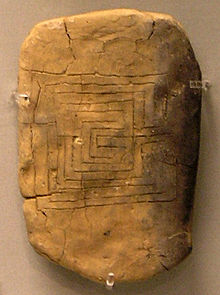
linear b tablet
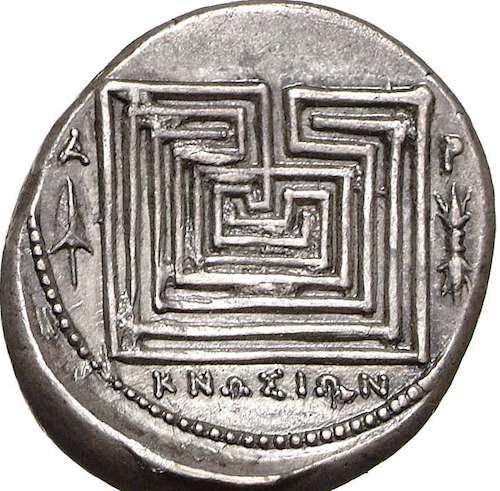
these tablets were administrative records for recipes used in ritual offerings to gods worshipped by this minoen religious cult/(s), and bare the earliest known reference to a god named dionysus and one named zeus.
“A relatively recent surprise is the firm evidence that the cult of Dionysos was active in the 13th century BC.14 From the site of Khania (KH) in western Crete, we have a tablet that records offerings of amphorae (two-handled transport-storage jars) of honey to Zeus and to Dionysos in a sanctuary of Zeus.”
KH Gq 5
.1 to the precinct of Zeus to Zeus AMPHORA of honey 1
.2 to Dionysos AMPHORA of honey 2
another linear b tablet appears to prescribe a human sacrifice to potnia.
PY Tn 316 (see the photo of Tn 316 frontside, p. 440) front side
.1 Within [the month] of Plowistos? (or Phlowistos? or Prowistos?)a
.2 performs a holy ritualb at Sphagianes, and brings gifts and leads po-re-na
.3 PYLOSc to potnia GOLD CUP 1 WOMAN 1
.4 to Manassa GOLD BOWL 1 WOMAN 1 to Posidaeia GOLD BOWL 1 WOMAN 1
.5 to Thrice-Hero GOLD CHALICE 1 to House-Master GOLD CUP 1
the myth of the minotaur is of a labyrinth located in knossos on the island of crete where fourteen children are sacrificed to a bull(half man) each year until a hero eventually slays it. not far from the ruins of the palace of knossos archeologists have discovered hundreds of children’s bones in a subterranean basement-like structure believed to have been used for religious cult rituals. knife marks on the bones indicate that cretan religious cults had practised ritual child sacrifice and also cannibalism:
“In a LM IB context in excavations just to one side of the Royal Road some distance northwest of the Little Palace at Knossos, 327 children's bones were found in a burnt deposit in the basement of a building christened the North House. Originally attributed to between eight and eleven children provisionally aged between ten and fifteen years old, between 21% and 35% of these bones, which included skull fragments as well as other bones, all found in an unarticulated heap, exhibited "fine knife marks, exactly comparable to butchery marks on animal bones, resulting from the removal of meat. Cannibalism seems clearly indicated. Among possible interpretations are ritual usage (otherwise unexampled in the open town of Knossos) and lack of all other food because of poisoning or other deleterious effect of gases or fall out from intense activity of the volcano of Thera." Subsequent analysis has revealed that the bones in fact need belong to no more than four individuals, two of whom can be quite precisely aged by means of their teeth to eight and twelve years. Some phalanges (finger or toe bones) from young humans, a human vertebra with a knife cut, some marine shells, some shells of edible snails, and burnt earth were found filling a pithos in the "Cult Room Basement", a room across a corridor from the "Room of the Children's Bones" in which the cache of 327 children's bones were found. The context within the pithos suggests that some portions of young children were cooked together with a variety of other edible substances. Together with the major concentration of children's bones were also found some sheep bones including articulated vertebrae. One of the latter had a cut mark in a position indicating that the beast's throat had been slit, so that sheep sacrifice may have been connected with the death and dismemberment of the children, whom forensic experts have established to have been in perfect health at the time of their deaths. ”
so there’s some evidence to suggest the myth of the minotaur was based in truth, and the term ‘myth’ shouldn’t be taken to mean fiction anymore than a painting done of a landscape. but why then were the sacrifices in the myth made to a minotaur(bull) rather than a goddess? well, if the labyrinth was potnia’s then assumedly the minotaur was too. potnia was likely a minoan archetype of the earth mother goddess which can be ultimately traced back to the ancient babylonian goddess ishtar(also known as the sumerian goddess inanna).
“The worship of the Anatolian Great Mother Cybele may perhaps be regarded as a contribution from a Hittite Society which by this time had long been extinct on every plane of social activity except the religious—though, if we set ourselves to trace the Great Mother back to her ultimate origin, we shall find her originally at home in the Sumeric World under the name of Ishtar, before ever she established herself as Cybele at Pessinus.”
“The general conclusion, as it seems to me, is that we are in the presence of a largely Monotheistic Cult, in which the female form of divinity held the supreme place. It is, indeed, substantially the same form of Religion as that so widespread, still at a later date, throughout the Anatolian and bordering Syrian regions. The Minoan Goddess is a Sister form to Astarte, and the Syrian Goddess, to Ma, to Kybele—identified with Rhea—and to other kindred divinities. And in the one case, as in the other, we have this female type associated, as son or as paramour or consort, with a young male satellite, such as is represented by Adonis, Kinyras, or Attis.”
in the babylonian epic of Gilgamesh, found on clay tablets dated from around 2000-1500 b.c, the goddess ishtar sends a heavenly bull of destruction to earth to go after a guy named gilgamesh who rejected her. this bull wreaks havoc upon the world before gilgamesh slays it, tearing it to pieces which he tosses back to ishtar except for its heart.
if potnia(also known under the name Rhea) was a minoan version of ishtar, the minotaur could be a minoan version of her heavenly bull, which like the heavenly bull is slayed by a hero. in caananite civilisation, which overlapped with minoan in predating greek, child sacrifices were made to appease gods in the image of bulls called baals, such as baal hammon(moloch) in carthage. these baals were often the male consorts of goddesses which fit the archetype of ishtar, such as that of the goddess tanit in carthage, moloch's consort.
“When the Carthaginians were defeated and besieged by Agathocles, they ascribed their disasters to the wrath of Baal; for whereas in former times they had been wont to sacrifice to him their own children, they had latterly fallen into the habit of buying children and rearing them to be victims. So, to appease the angry god, two hundred children of the noblest families were picked out for sacrifice, and the tale of victims swelled by not less than three hundred more who volunteered to die for the fatherland. They were sacrificed by being placed, one by one, on the sloping hands of the brazen image, from which they rolled into a pit of fire.”
greek civilisation was a cultural mixture of predominantly minoan and caananite civilisations. according to greek origin myths shrouded with mystery, the first influential greek religious cults were founded by an oracle named orpheus who worshipped the gods apollo(zeus) and dionysus.
“On this analogy we might reconstruct the actual religious history of the Hellenic World: the revival of the ancient and traditional Mysteries of Eleusis and the invention of Orphism—‘a speculative religion, created by a religious genius’, according to Nilsson—-out of a syncretism between the orgies of the Thracian Dionysus and the Minoan mysteries of the birth and death of the Cretan Zeus. ”
the orphic rites of dionysus in greece were a ritual reenactment of the god’s origin myth according to orphic legend. in it dionysus was torn to pieces as an infant by the titans, his body parts cooked and eaten, but his heart saved and given to a goddess who used it to resurrect him. it was a death and resurrection ritual.
“In Orphic legend (i.e., based on the stories of Orpheus), Dionysus—under the name Zagreus—was the son of Zeus by his daughter Persephone. At the direction of Hera, the infant Zagreus/Dionysus was torn to pieces, cooked, and eaten by the evil Titans. But his heart was saved by Athena, and he (now Dionysus) was resurrected by Zeus through Semele.”
james frazer noted that human sacrifice persisted in greek civilisation through the rites of dionysus, and he specifically mentions a place in Boeotia named potniae where children were killed and eaten according to these rites:
“Meantime it remains to point out that in some places, instead of an animal, a human being was torn in pieces at the rites of Dionysus. This was the custom in Chios and Tenedos; and at Potniae in Boeotia the tradition ran that it had been formerly the custom to sacrifice to the goat-smiting Dionysus a child, for whom a goat was afterwards substituted.”
boeotia was a region settled by the dorians after they conquered minoan civilisation and absorbed certain aspects from its culture. the central political authority in boeotia was the city of thebes which had been ruled by dorian oligarchs allied with those in sparta.
there’s a story in an anonymous homeric poem from around the seventh century b.c of the sacrificial practises performed by religious cults in knossos being shipped over to pylos in mainland greece through worship of the god apollo.
“Then Phoebus Apollo pondered in his heart what men he should bring in to be his ministers in sacrifice and to serve him in rocky Pytho. And while he considered this, he became aware of a swift ship upon the wine-like sea in which were many men and goodly, Cretans from Cnossos, the city of Minos, they who do sacrifice to the prince and announce his decrees,”
in it the god apollo declares he is the son of zeus and selects a group of cretan priests from knossos to travel to delphi and establish a temple there in his name - the temple of apollo. the phrygian oracle orpheus then founded the cult of apollo and another to dionysus, both of which observed mysterious 'orphic rites' of initiation, which involved in some persuasions, child sacrifice and cannibalisation to a god worshipped in the image of a goat or bull.
“A feature in the mythical character of Dionysus, which at first sight appears inconsistent with his nature as a deity of vegetation, is that he was often conceived and represented in animal shape, especially in the form, or at least with the horns, of a bull. Thus he is spoken of as ‘cow-born’, ‘bull’, ‘bull-shaped’, ‘bull-faced’, ‘bull-browed’, ‘bull-horned’, ‘horn-bearing’, ‘two-horned’, ‘horned’. He was believed to appear, at least occasionally, as a bull. His images were often, as at Cyzicus, made in bull shape, or with bull horn; and he was painted with horns. ”
robert graves provides some further detail on the orphic rites of dionysus:
“The Minocapros goat-cult in Crete seems to have been intermediate between the cults of Minelaphos and Minotaur.
[further down. . .]
The goat-Dionysus, or Pan, was a powerful deity in Palestine. He may have come there from Libya by way of Egypt or taken a roundabout northern route by way of Crete, Trace, Asia Minor and Syria.
[further down. . .]
The clue is to be found in the well-known Orphic formula: Like a kid I have fallen into milk, which was a password for initiates when they reached Hades and were challenged by the guardians of the dead. They had become one with The Kid, that is to say the immortal Dionysus, originally Cretan Zagreus or Zeus, by partaking of his flesh, and with the Goat-goddess, his mother, in whose cauldron and milk he had been seethed"
pythagoras was thought to have been initiated into the orphic doctrine on the island of crete and absorbed its teachings into his brotherhood. robert graves writes:
“It has been mentioned in Chapter IV that Pythagoras was a Pelasgian from Samos who developed his doctrine of the Transmigration of Souls as the result of foreign travels. According to his biographer Porphyrius he went Crete, the seat of the purest Orphic doctrine, for initiation by the Idaean Dactyls. They ritually purified him with a thunderbolt, that is to say they made a pretence of killing him with either meteoric stone or a neolithic axe popularly mistaken for a thunderbolt; after which he lay face-downwards on the sea shore all night covered with black lamb’s wool; then spent ‘three times nine hallowed days and nights in the Idaean Cave ‘; finally emerged for his initiation. Presumably he then drank the customary Orphic cup of goat’s milk and honey at dawn(the drink of Cretan Zeus who had been born in that very cave)”
graves also gives the creation myth central to the orphic doctrine, which the gnostics would later adopt.
“for the creation of the world, according to the Orphics, resulted from the sexual act between the Great Goddess and the World-Snake Ophion. The Great-Goddess herself took the form of a snake and coupled with Ophion; and the coupling of snakes in archaic Greece was consequently a forbidden sight—the man who witnessed it was struck with the “female disease”: he had to live like a woman for seven years, which was the same punishment as was permanently inflicted on the Scythians who sacked the Temple of the Great Goddess of Askalon. The caduceus of Hermes, his wand of office while conducting souls to Hell, was in the form of coupling snakes. The Goddess then laid the world-egg, which contained infinite potentiality but which was nothing in itself until it was split open by the Demiurge. The Demiurge was Helios, the Sun, with whom the Orphics identified their God Apollo—which was natural, because the Sun does hatch snakes eggs—and the hatching-out of the world was celebrated each year at the Spring festival of the Sun, to which the vowel Omicron is assigned in the alphabet. ”
the orphic sun god apollo was adopted by the dorian oligarchs who worshipped him at the head of their pantheon in sparta. the most important spartan festival, gymnopaedia, celebrated apollo with public displays of naked boys:
“In Sparta, where the behaviour and outlook on life of the people was noticeably different from the rest of Greece, the Gymnopaedia, or naked boys’ dance, was held annually as a kind of war memorial to the Spartans who had fallen at Thyrce. This was celebrated with dances and gymnastic performances of naked boys. The festival, so far from being regarded in the light of relaxation, was treated with such veneration as to be given preference over everything else.”
see, the orphic rites would also appear to be the origins of greek pedophilia, as orpheus himself had been known as, “orpheus, the first pederast”. as ovid writes:
“orpheus had abstained from the love of women, either because things ended badly for him, or because he had sworn to do so. Yet, many felt a desire to be joined with the poet, and many grieved at rejection. Indeed, he was the first of the Thracian people to transfer his affection to young boys and enjoy their brief springtime, and early flowering this side of manhood.”
pedophilia had been mostly a practice observed in crete, sparta, and other dorian dominated city-states. plato had pointed this out when addressing how the differing views on the practise should be reconciled between city states were they to merge into a universal one of common laws.
in his book symposium, plato makes the distinction between two types of pedophilia. one type practised by men in lust which should be outlawed. another by educators for the good of the child which should be encouraged. plato's distinction being that sex between a boy and man in the pursuit of lust was basely and predatory, but between an educator and his pupil, a bond conducive to imparting wisdom from one to the other and thus pursued for noble ends. or pedophilia "for the greater good".
“Men who are sections of the male pursue the masculine, and so long as their boyhood lasts they show themselves to be slices of the male by making friends with men and delighting to lie with them and to be clasped in men's embraces; these are the finest boys and striplings, for they have the most manly nature. Some say they are shameless creatures, but falsely: for their behavior is due not to shamelessness but to daring, manliness, and virility, since they are quick to welcome their like. Sure evidence of this is the fact that on reaching maturity these alone prove in a public career to be men. So when they come to man's estate - they are boy-lovers, and have no natural interest in wiving and getting children, but only do these things under stress of custom; they are quite contented to live together unwedded all their days. A man of this sort is at any rate born to be a lover of boys or the willing mate of a man, eagerly greeting his own kind. “
this was the spartan outlook on pedophilia and has been the justification of the boylover movement ever since. however, plato being plato, also provided a loophole for educators to pursue boys as objects of lust aswell.
“For suppose that a youth had a lover he deemed to be wealthy and, after obliging him for the sake of his wealth, were to find himself deceived and no money to be got, since the lover proved to be poor; this would be disgraceful all the same; since the youth may be said to have revealed his character, and shown himself ready to do anyone any service for pelf, and this is not honorable. By the same token, when a youth gratifies a friend, supposing him to be a good man and expecting to be made better himself as a result of his lover's affection, and then finds he is deceived, since his friend proves to be vile and destitute of virtue; even so the deception is honorable. For this youth is also held to have discovered his nature, by showing that he would make anyone the object of his utmost ardor for the sake of virtuous improvement; and this by contrast is supremely honorable. Thus by all means it is right to bestow this favor for the sake of virtue. “
and so we find in the works of plato, not just the origins of totalitarian political theory, but elite pedophilia aswell.
in his book timaeus, plato had also given the orphic creation myth, refering to the creator of the universe as the demiurge(sun, hellios, apollo). this is what was picked up on by gnostics studying him at the library of alexandria and why you find snakes and eggs in gnostic symbolism. the gnostic pursuit of ‘gnossos’, which was 'knowledge' before it was taken by some to mean moral liberation, would derive from ‘knossos’, also spelt ‘cnossos’ or ‘gnossos’, the city from where apollo(the demiurge/sungod) picked his sacrificial priests to establish his temple in delphi.
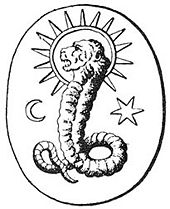
demiurge
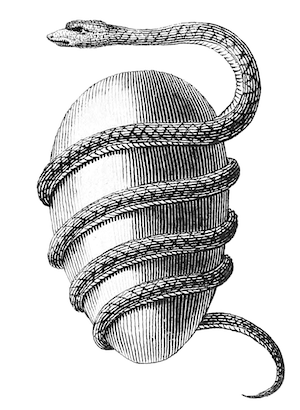
orphic egg
by the roman era the orphic doctrine had been integrated into deviations of its greek cults. the cult of dionysus had become the roman cult of bacchus. the orphic worship of apollo had been woven with persian zoroastrian influences into a high powered military cult who worshipped a sun-god named mithras.
“Nonnus, the Orphic writer, explains the shift in Crete from the goat to the bull-sacrifice by saying that Zagreus, or Dionysus, was a horned infant who occupied the throne of Zeus for a day. The Titans tore him in pieces and ate him after he had raced through his changes of shape: Zeus with the goat-skin coat, Cronos making rain, as inspired youth, a lion, a horse, a horned snake, a tiger, a bull. It was as a bull that the Titans ate him. The Persian Mithras was also eaten in bull form.”
after caesar crossed the rubicon and replaced the senatorial oligarchy with a militaristic julio-claudian imperial dynasty, the cult of mithras gained a following within elite roman society and was eventually formalised in the cult of sol invictus. emperors from augustus to constantine would be depicted with sol invictus sun spiked rays of light emitting from their heads, which became the traditional crown for monotheist monarchies. for a time during the brief reign of emperor elagabalus(marcus aurelius antoninus) the cult of sol invictus would publicly sacrifice children to a syrian sungod named elagabalus, or baal, who was worshipped in the image of a black stone meteorite, called a baetylus, sacred to the roman cult which worshipped a phrygian earth mother goddess named cybele.
“Emperor Elagabalus, the crowned high priest of Sol Invictus, sacrificed to the sun god every morning. During these daily rites, for which he stood in front of the altar, presumably in a particular attitude and facing in a particular direction, the amplissimus sacerdos wore typically Syrian robes ornamented with precious stones. His face was decorated with red and his eyes were made up. Accompanied by a group of women who danced and struck music from strange instruments, he proceeded from the imperial palace to the Elagabalium, around which the various altars had been placed in readiness. He made the round of the altars, performing sacred dances as he went. It may be that he himself examined the entrails of the young children that had been sacrificed, for he was preeminently the sacra cognoscens 3 of the mysteries of Sol Invictus and could therefore provide decisive elucidation and final pronouncement.”
[.......]
“By abstaining from pork, circumcising himself and casting into the Elagabalium the sexual organs of those whom he had mutilated, he repeated in Rome what occured frequently in his native country. If he sacrificed children to his god, at Hierapolis the most fervent adherents among the faithful hurled their own children down into the open space in front of the temple. The innumerable excesses of Elagabalus, which historians have seen as an expression of mental derangement or insanity, were nothing but the practice of certain Syrian customs on a scale made possible by his imperial power. ”
[.......]
“The greatest repugnance, however, was evoked by the sacrifices of young children, not the ugly or deformed but the most beautiful; not the children of lower-class citizens, but those of the highest functionaries and dignitaries of Rome'. Such practices could not fail to invite opposition.”
given elagabalus was also known as ‘baal’ and children were sacrificed to him, he was probably an adaption of the caananite deity baal hammon, otherwise known as moloch, making cybele a phrygian, and then roman, adaptation of the caananite goddess tanit, moloch’s consort.
so around 200 a.d roman elites were openly making child sacrifices to a baal under the name elagabalus, the very thing they’d once condemned the carthaginians for. the praetorian guard assassinated the emperor and put an end to this practise pretty fast, and whatever remained of the cult went back underground. but we get an interesting glimpse at the last well documented institutionalisation of child sacrifice, and its association with a black meteoric stone sacred to a phrygian goddess named cybele, whose male cultists would castrate themselves.
orpheus had been a phrygian, often depicted wearing the iconic phrygian red cap, and the orphic rites of initiation pythagoras had been inducted into involved the use of a meteoric black stone knife. the son of the phrygian goddess cybele had been a bull god named sabazius, also known as sabazius dionysus to the phrygian orphics, and the god worshipped by the orphic cult of dionysus. sabazius was conjectured by some to have also been the origin of the god worshipped by jews.
let me borrow from graves at length to explain this:
“This mythological rigmarole adds up to an identification of the Israelite Jehovah of Tabor, or Atabyrius, with Dionysus the Danaan White Bull-god: an identification which rests on respectable Classical authority. In Plutarch’s Convivial Questions one of the guests claims to be able to prove that the God of the Jews is really Dionysus Sabazius, the Barley-god of Thrace and Phrygial and Tacitus similarly records in his History (v. 5) that ‘some maintain that the rites of the Jews were founded in honour of Dionysus.’ Also, the historian Valerius Maximus records that about the year 139 B.C the Praetor of Foreigners, C. Cornelius Hispallus, expelled from Rome certain Jews who were ‘trying to corrupt Roman morals by a pretended cult of Sabazian Jove.’ The inference is that the Praetor did not expel them for a legitimate worship of this god, but because they foisted novelties on the Tracian cult—probably circumcision, which was regarded by the Romans as self-mutilation and a corruption of morals—for they admitted aliens to their Sabbaths. According to the Leclerq’s Manual of Christian Archaeology, burials in the cemetery of Praetextatus at Rome confirm this cult of a Jewish Sabazius. That the Jews of the Dispersion may have used false etymology to equate ‘Sabazius’ with ‘Sabaoth’—Jehova was the Lord of the Sabbath, and also of Sabaoth, ‘of hosts’—does not dissprove the original identity of two gods.
Sabazian Zeus and Sabazian Dionysus were different names of the same character, the Son of Rhea; which meant that he was of Cretan origin. The Phrygians called him Attis and made him the son of Cybele, but this amounted to the same thing; and an inscription of jewish origin has been found in Rome: ‘To Attis the Most High God who holds the Universe together.’ The serpent was sacred to Sabazius and this recalls the Brazen Seraph Ne-esthan or Nehustan, which Moses used as a standard and which is said to have been destroyed as idolatrous by Good King Hezekiah because incense was burned to it as to a god. But the jewish sect of Orphites, centered in Phrygia, revered the Serpent in early Christian times, holding that the post-exilic Jehovah was a mere demon who had usurped the Kingdom of the Wise Serpent, the Anointed One. Sabazian Dionysus was represented with bull’s horns because, as Diodorus Siculus records, he was the first to yoke oxen to the plough for agriculture: in other words to plant barley. Since Jehova was pre-eminently protector of barley—the Passover was a barley harvest-festival—Plutarch’s convivial guest would have had little trouble in proving his contention, especially since, according to the legend, Sabazius was torn by the Titans into seven pieces. Seven was Jehovah’s mystical number.”
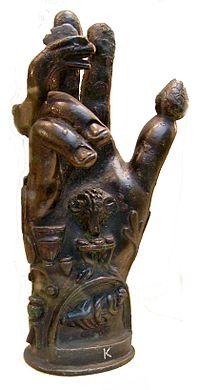
hand of sabazius, bronze idol of the sabazius cult in rome, 1st–2nd century CE
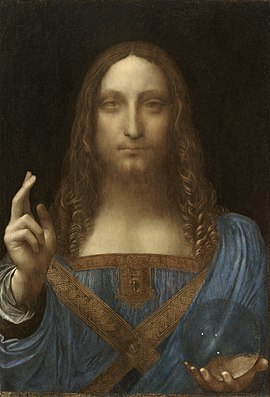
'salvator mundi', painting of jesus by leonardo da vinci, 1499-1510, assumedly commissioned by medici family
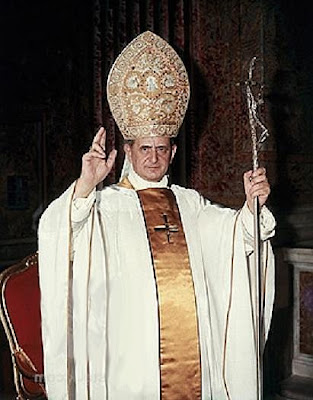
pope paul vi
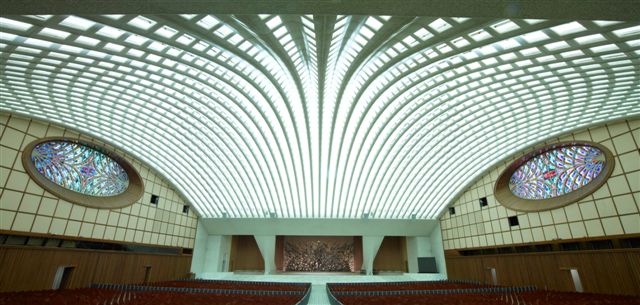
pope paul vi audience hall at the vatican
the ultimate significance of the teachings imparted on the pythagorean brotherhood through the orphic mysteries by this cult of mystical phrygians was the philosophical belief in a literal separation between heaven and earth known as dualism. the pythagoreans called this 'the transmigration of the soul'. which was the evolution in thought that created western monotheism. dualism can be best understood in its most literal sense.
it was a shift from worshipping the earth as a goddess to worshipping the sun as a god. which created a literal separation between the spiritual realm and nature by shifting the spiritual realm from earth to the sun above us. since we cannot touch nor even directly look at the sun, this new spiritual realm could now only be experienced through imagination/meditation, allowing it to become whatever we wanted it to be. so it became perfect and good. but if that was true, then from where came bad? the old pagan gods/goddesses had been accepted as both good and bad in the kind of erratic way nature behaves. by transferring good from nature to the spiritual realm, nature was left with only bad. thus nature became evil, and as a result human nature became evil as well. this evolution in thought is what robert graves lamented as the grave contradiction of philosophical dualism.
“The result of envisaging this god of pure meditation, the Universal Mind still premised by the most reputable modern philosophers, and enthroning him above Nature as essential Truth and Goodness was not an altogether happy one. Many of the Pythagoreans suffered, like the Jews, from a constant sense of guilt and the ancient poetic Theme reasserted itself perversely. The new God claimed to be dominant as Alpha and Omega, the Beginning and the End, pure Holiness, pure Good, pure Logic. . . .The outcome was philosophical dualism with all the tragi-comic woes attendant on spiritual dichotomy. If the True God, the God of the Logos, was pure thought, pure good, whence came evil and error? Two separate creations had to be assumed: the true spiritual Creation and the false material Creation.”
dualism separated god from nature, but in doing so separated good from evil. if god was pure good, then from whence came evil? it had to be nature. and since humans were apart of nature human nature became evil and only made good through god's good grace.
generally speaking, the most harmful philosophies ever since have been the ones that have adopted this dualist belief that human nature is evil, as these justify instituting strong controls on human behavior. this is why dualist philosophies have been the ones popularised by oligarchs ever since. from the christian notion of original sin, through to hobbes and darwnism, the underlying dualist principal remained the same - the flesh was always evil. “nature is evil you must be saved by god” simply became “nature is evil you must be saved by science”. and babies went from being baptised to being vaccinated.
the dualist maxim “as above, so below” can be taken to mean - the natural world of material evil should be made to reflect the spiritual world of logical good. the pythagorean solution was to convert the material world into the spiritual one through the power of numbers. the monotheist solution was through the power of words to create heaven on earth. the latter method is what got institutionalised as the control mechanism used by european monarchies. however, with the advent of the printing press and rising literacy rates, the power of words started to wane as people could now read and go directly to the source of religious texts and adopt their own interpretations rather than having to rely on a bureaucrat from the catholic church to middle-man the interpretation for them ‘in mass’. monotheism was losing its potency, not as an ethical system based on the teachings of jesus christ, but as an authoritative institution which could control behavior through controlling "truth".
by the renaissance this issue had become acute and we start to see the pythagorean number method become of interest to powerful groups, like medici, who’d relied on the uniform interpretation of the bible as a control mechanism through controlling appointments of key positions within the vatican. by the enlightenment there had developed a political agenda to replace this with the pythagorean method of control with numbers, which began instigating a series of revolutions to bring about this change. and the lore surrounding the pythagoreans dredged up a whole bunch of pagan and gnostic superstitions concerning the origins of their teachings. this alternative history became the obsession of aristocratic secret societies of the 18th century, which started looking to the greek mysteries to find their "true god" and satiate their spiritual needs.
for instance, the dilettanti society, a scholarly adjunct of francis dashwood’s hellfire clubs, had funded archeological expeditions during the mid 18th century to delphi and other areas of greece where temples to apollo and dionysus had been located. dashwood had erected statues to dionysus and apollo in the hellfire caves, one of which dashwood had named after benjamine franklin who was reputedly a member during his time in england. franklin had spent twenty years going back and forth between paris and london before heading back to america in 1775 to establish the US post office and become its first postmaster general. he would help draft the declaration of independence and ensure the design of the great seal of the united states contained the following specifications.
“Four features recommended by the first committee and its consultant were later adopted in the final seal: the Eye of Providence and the date of independence (MDCCLXXVI), both of which appeared on the final reverse side of the seal, and the shield and Latin motto, E Pluribus Unum (Out of many, one), on the obverse side.”

great seal of the united states
franklin returned to europe in 1776 as the US ambassador to france and became the key player in franco-american diplomacy until thomas jefferson succeeded him in 1785. both franklin and jefferson forged close ties with the du pont family there, who would become founders of america's largest chemical conglomerate. franklin worked closely with du pont family patriarch pierre samuel du pont de nemours, who had been the inspector general of king Louis XVI’s chamber of commerce. thomas jefferson had worked closely with pierre’s son, victor marie du pont. when jefferson became president in 1801 the du ponts relocated to america and pierre joined jefferson’s administration and starting drafting the nations educationl scheme, while his son, eleuthere du pont, started the family's industrial chemical dynasty. the du pont family today, over 200 years later, are responsible for launching the political career of 2021 US president joe biden, who'd been their man in delaware as a senator. a testament to the continuity of their influence.
prior to the french revolution eleuthere du pont had been the protege of antoine lavoisier, a rather famous french chemist who kept a lab at the royal arsenal as well as a keen eye over the nation's gunpowder reserves. these reserves would be transferred to the bastille just days before it was famously stormed. this event is generally seen as an epoch to the french revolutionary period, as the barrels of gunpowder seized suddenly made the muskets in the hands of revolutionary factions a real threat. the french monarchy no longer had a monopoly on firearms, their palace was stormed in versailles, and they were forced to recognise the constitutional reforms put to them by those in control of the mobs.
so phase one of the french revolution kicks into gear and absolute monarchy is moderated with constitutional assembly. the royal family are held in their palace under the lock and keep of a new national guard led by a war-hero named lafayette. the new national constituent assembly takes power led by a key provocateur of the mob violence which brought it to power, honore gabriel riqueticount, better known as count mirabeau.
mirabeau had been the leader of the jacobins and an established aristocrat within the palais-royal where he'd authored libertine pornography. a close friend of mirabeau's named joseph alexander hupay de fuvea had himself authored a french version of plato’s republic published in 1779 called ‘the project for a philosophical community’. as billington quotes from that text:
“All would speak french, ‘the language of reason and truth,’ and children would be educated communally up to age five to insure freedom from past prejudices. Rigid ‘tables of exercise and studies’ were prescribed for subsequent education, and a Plan Geometral drawn up for the community featuring two large statues: ‘the divide PLATO, Prince of Legislators, Inventor of the Communal Life(Communaute de vie)’ and ‘J.J. ROUSSEAU, Citizen of Geneva, Investigator of the principals of Human Education’ A privileged exit from this ‘house of meeting’ of the community was shown leading to a special place for ‘communities formed by Childen married within the Philosophical Community.’ This was presumably a kind of philosophical master race living in ‘equality and union’ and ‘the most perfect sociability’. ‘a Spartan people, the true nursery of a better race of men than ours’”
mirabeau had also been in letter correspondance with rousseau as far back as the 1760s regarding whether despotism could best be justified on a basis of natural right or arbitrary god.
" Here, in my old ideas, is the great problem in Politics, which I compare to that of squaring the circle in Geometry, and to that of longitudes in Astronomy. Find a form of government that puts law above man.
If this form can be found, let us look for it and try to establish it. You claim, Gentlemen, to find this dominant law in the evidence of others. You are proving too much: for this evidence must have been in all governments, it will never be in any.
If unfortunately this form cannot be found, & I candidly admit that I believe it is not, my opinion is that we must go to the other end & suddenly put the man as much above the law as he can be, consequently establish arbitrary despotism & as arbitrary as possible: I would like the Despot to be God. In a word, I see no bearable medium between the most austere Democracy and the most perfect Hobbism: for the conflict between men and laws which brings about a continual internal war in the State, is the worst of all political states."
mirabeau had likely been an actual initiated member of the bavarian illuminati during his time as french ambassador to berlin.
“The decisive book in popularizing the illuminati ideal was Count Mirabeau’s ,The Prussia Monarchy under Frederick the Great, which also appeared in 1788. Written in large part by a former Illuminist, Jakob Mauvillon, Mirabeau’s work distinguished rationalistic Illuminists from ‘mystical’ occultists, hailing the former as leaders of a movement the ‘great aim’ of which was ‘the improvement of the present system of governments and legislations’. Mirabeau took much of his new, totalistic concept of ‘the revolution’ directly from Illuminist models; he almost certainly transmitted something of this ideal to his influential proteges.”
the mobs of the french revolution, which ultimately brought mirabeau and his jacobins to power, had often used the palais-royal as a point of assembly, and were in large part brought to assemble there by the agitation propaganda of a publishing society within the palais-royal called the social cercle. the social cercle, a sort of propaganda publishing house, had been formed by a journalist named nicholas bonneville, who’d been schooled in illuminati doctrine by a member of the order named christian bode, who'd travelled to france just a few years prior to the revolution in 1787.
“Nicholas Bonneville was, however, the decisive channel of Illuminist influence. He was converted to Illuminist ideas during the first of two visits to Paris (in June 1787) by Weishaupt’s leading associate in the final political stage of Illuminism, Christian Bode.”
it is also known the illuminati had a man in the french national guard, lafeyette’s second in command, savalette de lange(charles pierre-paul), who had been initiated into the secret society by christian bode in 1787. thus it would seem the illuminati had members or agents within key positions of the revolutionary press(bonneville), political apparatus(mirabeau), and military(de lange) in the years preceeding the reovlution.
the ‘secret doctrine’ of the illuminati was more pragmatetic than anything to do with the occult, and embodied the philosophical belief of pythagorean rationalism and political theory of plato, with aims to bring about political change along these lines through conspiratorial means. it was basically a spy agency using subversive tactics to bring about regime change.
“Weishaupt appears to have been the first to use the term ‘circle’ to designate a new type of political organisation making both individual moral demands and universal ideological claims. Weishaupt described his recruitment of Illuminists from within Masonic lodges in Munich as ‘the progress of the ⊙’ in the political area.”
“The circumpunct (circled-dot; dot within a circle) was indeed an important symbol for the Illuminati – in particular, it was used in internal correspondences, instead of writing the words “Order of the Illuminati”; similarly, when referring to a lodge a square symbol was used instead.
The symbol has a long history within Freemasonry, hermeticism, rosicrucianism, alchemy and astrology. It’s the alchemical symbol for gold but more anciently has always represented the sun.
For Weishaupt, however, his use of the symbol most certainly derived from the Monad symbol of the Pythagoreans, which was elaborated upon by Gottfried Leibniz in his Monadology of 1714. Weishaupt was greatly influenced by Leibniz and also revered Pythagoras and the ancient schools of wisdom. Look to what it meant to both Pythagoras and Leibniz and you can be sure that it was in this context that the Illuminati had used it.”
there's no need for any secret occult knowledge to figure out what the ultimate aim of the illuminati had been, or perhaps still are. since they were pythagorean rationalists and politically motivated, they obviously sought to institute plato’s totalitarian regime of philosopher kings. that is— the illuminati sought to bring about plato’s republic. rousseau even touches on this in his letter to mirabeau, when he writes,"So, gentlemen, you make your despots so many sages.":
"But suppose all this theory of natural laws always perfectly evident, even in its applications, and of a clearness which is proportionate to all eyes; how can philosophers who know the human heart give this evidence so much authority over the actions of men, as if they did not know that each is very rarely guided by his lights and very frequently by his passions. It is proved that the truest interest of the Despot is to govern legally; this is recognized at all times: but who is it that behaves on its truest interests? The sage alone, if he exists. So, gentlemen, you make your despots so many sages. Almost all men know their true interests, and do not follow them better for that. The prodigal who eats up his capital knows perfectly well that he is ruining himself, & still goes its course; what is the use of reason enlightening us when passion leads us?"
clearly neither democracy nor liberty had been the agenda behind the confusing series of developments on the surface of the french revolution. rather bizarrely, the assumption has been made, that since the revolution overthrew monarchy, it must have done so in the name of liberty and democracy, and many historians swallowed the propaganda of the period they studied.
“An undercurrent of fascination with Pythagorean thought in the High Renaissance and Enlightenment came to the surface during the French Revolution. Weishaupt’s final blueprint for politicized Illuminism, written during the first year of the French Revolution, was entitled Pythagoras; and, as extremists sought some simple yet solid principles on which to rebuild society, they increasingly turned for guidance to Pythagorean beliefs in prime numbers and geometric forms.”
but things never go according to plan for those trying to control them. count mirabeau had died early on in 1791, possibly poisoned, who knows, but was out of the equation. soon after lafayette lost control of the national guard in a coup by one of his commanders named antoine joseph santerre, who has been aided in this by savalette de lange, the illuminati's man in the national guard.
“From an officer of the national guard, he became aide-de-camp with Gouvion to the commander of the guard, General La Fayette, but would have betrayed the latter in the Vincennes affair set up by the Orléanist Santerre who was seeking to replace him ( which he did after August 10).”
the royal family had briefly escaped from the custody of the national guard leading to the denouncement of lafayette as a traitor by jacobin leaders danton and robespierre. antoine joseph santerre then took control of the national guard and used it to massacre the swiss royal guard and take the royals prisoner. the royal were then executed and the jacobins took over, establishing themselves as the committee of public safety under the leadership of maximillien robespierre in 1793, and went about purging their political opposition in what was known as the reign of terror. the jacobins drew up a new french constitution based on the laws of crete, but wouldn't be around long enough to institute it. but, do you see, that phrygian red cap somewhere in the illustration of the jacobin constitution?

Herault de Sechelles drafts constitution of ’93 based on laws of king minos of crete
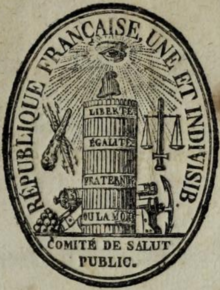
the committee of public safety
from the tumult of the reign of terror emerged a shadowy figure named filippo(philippe) buonarroti. this was the great-grandnephew of michelangelo, who'd been educated as a lawyer in florence where it’s speculated by some historians he’d been initiated into the illuminati order.
“It is possible, that 1786, he joined a Florentine lodge where, under the guise of practising the Scottish rites of the Masonic Order, the Illuminati (founded by Adam Weishaupt in 1776) may have been propagating their radical interpretation of the Discours sur L’Inegalite and the Contrat Social. Although his initiation into Weishaupt’s order remains conjectural, his later familiarity with it is certain and was to be of paramount importance in his future development. In 1786, the Florentine government found it necessary to raid his library and confiscate a number of works, published in France, containing anticlerical and masonic propaganda.”
“A hint that Buonarroti may even have been committed to Illuminism is provided in a forgotten journal of 1789 by a group of young Italians who had been influenced by Illuminism while studying in Bavaria Excited by the political news from France, these students drew up plans in Innsbruck(“Samos”) to set up a journal capable of promoting the total transformation of humanity set forth in the Illuminati ideal. Late in 1789, they published in Sondrio, on the Italian side of the Alps, a journal that may well have been the first ideological revolutionary organ of modern times: Political Appendix to all the gazettes and other news sheet.
[further down]The first issue praised the Weishaupt-Mirabeau concept of a ‘revolution of the mind’ as the proper objective of the ‘century of the illuminated’. It identified this type of revolution with the Bavarian Illuminists (“the company which Count Mirabeau has compared to the Priests of Eleusis“), and distinguished their ideal from spiritualist distorters. The editor followed the Illuminist practise of adopting a pretentious pseudonym, “Lazzaro Jona” (suggesting perhaps Lazarus, Jonah, and the return of truth from death), and hailed as a friend ‘Abraham Levi Solomon’, the recorder of the patriotic Journal of Corsica. A footnote identified this figure as ‘the cavalier Bounarroti’ a ‘man of spirit’ “
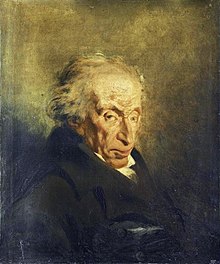
filippo giuseppe maria ludovico buonarroti
buonarroti had journeyed to the island of corsica in 1789 where he became closely acquainted with the bonaparte family, particularly napoleon. corseca had been a place rousseau had described as the best basis for building a perfect island utopia, and buonarroti appeared to be following in the footsteps mirabeau, who had travelled on an expedition to the island during his youth aswell.
buonarotti became a member of jacobins there, working as a bureaucrat within its french administration before moving to paris in 1793 once robespierre's committee of public safety took power. in paris he became acquainted with the jacobin leader through connections he had with the duplay family. the committee of public safety assigned buonarroti commissioner of the french occupied italian territory of oneglia during the reign of terror. he was imprisoned after the committee on public safety was overthrown in 1794, but unlike robespierre and his jacobin intimates who were guillotined, buonarroti was spared and transferred to the prison of plessis where he met two other jacobin prisoners named francois-noel babeuf and augustin alexandre darthe. all three were soon released and formed a secret jacobin club called the pantheon society guided by a fourth man behind the scenes named sylvain marechal. marechal had been the leading intellectual within nicholas bonneville's social cercle at the palais-royal, who had introduced buonarroti's new acquaintance, francois babeuf, into it in the early 1790s which had allowed babeuf to establish his reputation as a prominent jacobin propagandist.
marechal had been a leader within the intellectual wing of the jacobins, and a pythagorean rationalist who authored a six-volume series called 'the voyages of pythagoras' in which he called for a violent revolution to institute the pythagorean ideal.
"The image of Pythagoras as the heroic model for all revolutionaries was most fully developed in the great valedictory work of Sylvain Marechal: his monumental, six-volume Voyages of Pythagoras in 1799.
Marechal's Pythagoras urged armed uprising ("not with words [but with] bow and arrow"), invoking a metaphor that was to become a classic of revolutionary rhetoric:
'It is necessary to seize the suitable moment. . . .with the smallest spark a great fire can be ignited. . .'
The ideal of the heirs of Pythagoras is:
'Own everything in common, nothing for yourself. . . the equality of nature. . .the republic of equals' "
bebeuf, darthe, and buonarotti, with marechal a guiding hand behind the scenes, used the pantheon society to plot what has become known as the “the conspiracy of equals“, which was a conspiracy to restore jacobin rule under a secret directory of public safety. this conspiracy would later be considered by founders of the communist revolutionary movement, to be the first true attempt at a communist revolution, based on a political phamphleet babauf had authored called the ‘plebian manifesto’.
buonarroti's old friend napoleon had gotten wind of this plot some how and arrested all the pantheon society members who were put on trial. babeuf and darthe were sentenced to death and executed, but strangely, both buonarotti and marechal were spared. which gives the impression babuef and darthe had perhaps been used as a patsy by those with grander designs. as billington speculates:
“The strange absence of references by Babeuf and the others to the man who formulated their ultimate objectives, Sylvain Marechal, could be explained by the existence of an Illuminist-type secrecy about the workings of the inner group. The conspirators may have viewed Marechal as the “flame” at the center of the “circle“. As such, he would have had to be protected by the outer circle against disclosure to profane outsiders.”
buonarroti spent a number of years locked away in prison until napoleon seized power in 1799 and arranged for his eventual release through a series of prison transfers that landed him as a freed man in a commune town called sospel located on the french-italian border around 1802. there buonarotti laid the groundwork for a secret society called sublime maitres parfaits(smp) modelled on the illuminati, if not a direct affiliation of its continuation.
“Recent research has shown that it was primarily the influence of the Illuminati of Bavaria that led Buonarotti to develop in the hostile environment of Empire and Monarchy a secret society based on a ‘metapolitical’ distinction between the ‘civilian’ society and the reforming order in its midst. In its structure, as well as in its gradualist aim, the Sublimes Maitres Parfaits closely resembled the order founded by Weishaupt in 1776. Its hierarchy, its methods of initiation, its employment of the catechism, all were almost identical with the structure of the Illuminati. Even the name of Buonarroti's organization evoked Weishaupt’s alias—”Spartacus”. The third and most secret credo of the Sublimes Maitres Parfaits— that which reffered to ’The Republic’ as ‘the sole proprietor’ and ‘to creating a social patrimony out of the ruins of private property’ as the ‘only regeneration aimed at by the philosophers’—was called the Areopagus. Among the Illuminati, the ‘areopagites’ were the chosen few who alone knew the real aim of the order, the date of its foundation, and the name of its founder.”
buonarotti founded sublimes maitres parfaits(smp) in geneva sometime between 1809-11 and used it to infiltrate, takeover, and subvert to its own agenda, various burgeoning revolutionary movements across the europe.
in france buonarroti's smp had infiltrated a persisting jacobin secret society called the philadelphes, which had plotted to assassinate napoleon in 1812. whether buonarroti had to do with the plot itself or its failure remains unclear, though napoleon didn’t see fit to go after his old friend over his involvement.around 1818-1820 buonarroti's smp had infiltrated the italian nationalist secret society, the carbonari, and subverted its nationalist aims to an internationalist agenda causing a schism amongst its ranks. buonarroti had recruited a young italian named alexandre andryane whom he initiated into the carbonari and sent on a mission to milan in 1823 carrying a trove of secret carbonari documents, including membership lists. his new recruit was met there by police and the internal workings of the carbonari network were exposed to the italian monarchist, allowing them to swiftly and successfully supress it.
buonarroti then relocated from geneva to brussels and changed name of sublimes maitres parfaits to ‘monde’. he wrote a book there called ‘the conspiracy of equals’ published in 1828, which was a kind of tributary account of the babeuf conspiracy along with his own blueprints for a totalitarian society based on plato’s republic and rousseau’s social contract. this book would go on to influence karl marx who would attempt to have it translated and published into english. as marx wrote:
"The first manifestation of a truly active communist party is contained within the bourgeois revolution, at the moment when the constitutional monarchy is eliminated. The most consistent republicans, in England the Levellers, in France Babeuf, Buonarroti, etc., were the first to proclaim these “social questions”. The Babeuf Conspiracy, by Babeuf’s friend and party-comrade Buonarroti, shows how these republicans derived from the “movement” of history the realisation that the disposal of the social question of rule by princes and republic did not mean that even a single “social question” has been solved in the interests of the proletariat"
buonarroti died in 1836 leaving an enigmatic legacy for historians to puzzle over. his biographer elizabeth eisenstein seemed to think he’d been tacitly serving the agenda of klemens von metternich, foreign minister and chancellor of austria during the napoleonic wars. which is also to say, in my own words not hers, the agenda of rothschild.
“However ‘efficient’ Buonarroti may have been, he led whatever organisations he led into a cul-de-sac. The positive results he may have achieved, were effectively cancelled out by Andryane’s capture. Recent research has shown that Buonarroti’s organization was not invented by Metternich. But no one has yet shown that the Sublimes Maitres Parfaits served any significant historic purpose other than to strengthen the latter’s hand by being discovered. ”
the two primary statesmen managing the affairs of the austrian habsburg empire during and after the napoleonic wars were johann philipp stadion and klemens von metternich. stadion had been a member of the bavarian illuminati before it had been ostensibly disbanded. and while metternich had been far too young to have been a member himself, his father franz george karl had also been a member.
metternich had stationed austrian troops in italy in 1821 to help the monarchy there suppress the carbonari uprising, at the time being instigated by buonarroti. the monarchy had been pressured into appointing luigi de medici as finance minister in control of their treasury as a result of this unrest. to finance the costs of the austrian expeditionary forces being stationed there, stadion as the austrian finance minister had arranged for the naples treasury to take on a series of burdensome loans from the rothschild family to meet the austrian demands for payment. these demands for payment were progressively increased to sink the italian treasury into further debt and carl rothschild, fourth son of the family, was sent there in 1822 to manage the debt, gaining control over the monarchy's purse strings.
“Stadion’s letter had revealed the whole plan that was to be carried out: Naples was to pay everything, and Rothschild was to arrange loans at the expense of that country, the proceeds of which were to be applied for paying for Austria’s unwanted intervention”
then suddenly, the following year in 1823, buonarroti sends one of his carbonari agents right into the hands of monarchist authorities in milan carrying a trove of documents exposing the organisations inner workings. as a result the carbonari uprising was swiftly suppressed and the austrian troops being stationed in italy were removed.
in fact, the same thing had happened to the monarchies in france, england, and austria, but through the need to raise funds to fight the napoloenic wars, or in the case of france pay reparations. objectively speaking, the most significant new power structure to arise from the tumult of the french revolution and napoleonic era was a kinship one. the rothschild family. and the most significant decline in power was a kinship one. the habsburg family. and over 200 years later in britain, a rothschild would still control a habsburg’s royal purse.
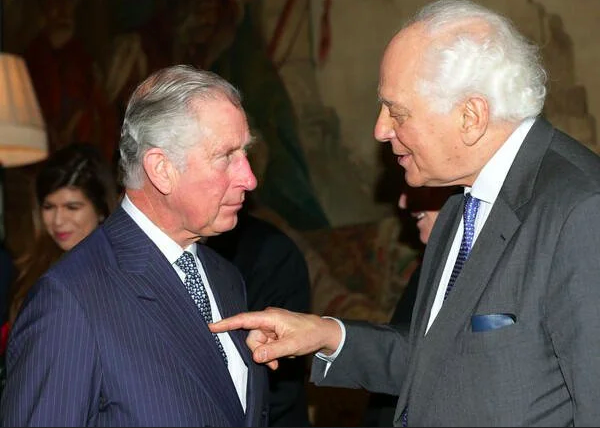
“Evelyn de Rothschild, who controlled the British wing of his family’s empire for nearly three decades, wielding his name and immense wealth in banking, government and at Buckingham Palace, where he advised Queen Elizabeth II on financial matters, died Nov. 7 at his home in London. He was 91.”
mayer rothschild, patriarch of the family, had built its initial fortune over a thirty year period in the late 18th century managing the finances of prussia’s wealthiest principality, the estate of prince william of hesse(William IX, Landgrave of Hesse-Kassel: 1743-1821). william’s brother, charles of hesse(karl/charles of Hesse-Kassel: 1744-1836), was a member of the illuminati under the alias 'aaron'. through this connection mayer’s two eldest sons, solomon and amschel rothschild, became established in austria and started managing the empires debt through the issuance and foreign exchange of warbonds used to finance armies to fight napoleon across the european continent. this business had been coordinated stadion and metternich, who controlled both austria’s treasury and foreign policy.
nathan rothschild, mayer's third eldest son, relocated to london in 1806 and started managing the english end of these transactions from within the city of london, where he became particularly involved in the financing of general wellington’s armies.
james rothschild, mayer's youngest son, was established in paris in 1811 through the assistance of an illuminati member named karl theodor von dalberg(1744-1817), and after napoleon had been defeated would manage the war indemnity payments owed by france to both england and austria.
“While Rothschild had always enjoyed Dalberg’s favor, this clever action gained for him the full confidence of the grand duke, as is indeed specifically stated in a later French police report regarding the Rothschild family: ‘Through meeting him in his good graces, that henceforth the grand duke scarcely ever refused him any request’. He asked for instance for a passport for young James, who was then nineteen years old, and who was sent through Antwerp to Paris, straight into the lion’s mouth. ”
by the time carl rothschild was sent to italy in 1822, the rothschild family had a firm grip over the treasuries of austria, france, england, and now italy. they used this to establish their own private courier service which would replace the thurn and taxis postal network used by european monarchies to communicate on diplomatic matters. this is the postal conspiracy thomas pynchon touches on in his historical "fiction" novel,the crying of lot 49.
“A large part of Germany was still served by the Thurn and Taxis post bureaus which were divided into lodges and non-lodges, according as their officials were or were not the confidential agents of the Viennese Cipher Service. If a letter came to a lodge office, it was carefully opened before being sent on, read through, and any important passages were copied. As these ‘intercepts,’ as they were called, were always laid before the authorities, such action. often abused, was greatly feared. ”
----[further down]----
“The brothers Rothschild naturally thoroughly understood the position. As they had a great deal to say to one another that they did not wish anyone else to hear and also attached great importance to the speedy receipt of news in advance of normal methods, they decided to have their own system of couriers. They would be reimbursed for the heavy expense of this arrangement at one stroke if their firm thereby received early news of any political event that might affect the exchange.”
“As the Rothschilds’ business expanded, their correspondance naturally became more voluminous, and they found it neccessary strongly to reinforce the system of couriers with which they had covered Europe. This circumstance entailed a consideration of the question whether their correspondence could be more closely watched.
In this connection the suggestion made by a Milan postmaster is illuminating. ‘I have noticed,’ he reported to Vienna, ‘that the Rothschild clerks who travel as couriers from Naples to Paris about once or twice a month take with them all the dispatches of the French, English, and Spanish ministers, accredited in Naples, Rome, and Florence. In addition to this not inconsiderable correspondence, they also deal with the communications passing between the courts of Naples and Rome and their legations at Turin, Paris, London, Madrid, Lisbon, etc., as well as all private letters that are of any importance.’---[further down]---
Since diplomatic correspondence was involved, this proposal concerned the chancellor, and was duly brought to Metternich’s notice. He felt that it would be awkward to accept the suggestion. The scheme could turn out to be a double-edged weapon, as he himself often made use of the Rothschild couriers, and matters of the greatest secrecy might come to the knowledge of the subordinate postal official. On the other hand, Metternich would have been exceedingly glad to get hold of the private correspondence between the brothers Rothschild and, as the technical term went, to submit it to ‘manipulation’.
The result of these considerations was the issue of the following order: ‘The couriers of the House of Rothschild passing through Lombardy on their way to Paris to Naples, or from Naples to Paris are, when carrying dispatches bearing the seal of the I. and R. Consulates-General in those cities, to be regarded and treated as official couriers,’---[further down]---
Homayr, the former director of the Vienna State Archives, who had been banished because of his associations with the Archduke Johann in his venture for founding the so-called ‘Alpine Kingdom,’ was a bitter enemy of Metternich and the emperor. He was thoroughly familiar with the manner in which correspondance was tampered with, and used this knowledge for making a violent attack upon Metternich and Solomon Rothschild. He even went so far as to state that Metternich had, in agreement with Solomon, waited at Fischamend, two stages from Vienna, for a post bearing important news from Constantinople, and held it up for two days.”
in this way the rothschild family gained control of both the financial and communication networks of european monarchies and leveraged these to grow in power and wealth throughout the 19th century. the most powerful member of the family to emerge under this new european order was nathan rothschild, who had married into another powerful banking family within the city of london named the cohens. nathan rothschild’s wife, hannah barent-cohen, was the cousin of nanette barent-cohen. the maternal grandmother of karl marx.
while the rothschilds and a fraternity of families around them, some closely allied others not, set out to finance the development of the industrial system, marx developed two key works. his first was a three volume tome called ‘das kapital’ meticulously detailing the flaws of industrial capitalism, rejecting its economic system - capitalism, while embracing its mode of production - industrialism. his second was a political phamplet of scant detail which remedied the issue by legitimising the private industrial monopolies being built by capitalists through public ownership. this was communism, an economic system in which the workers owned the means of production. it cannot be emphasised enough that marx never mentioned anything about the control of production. he only stated that workers should own the means of production collectively. which meant industrial era oligarchs would need only to separate controlling rights from ownership rights to legitimise the private monopolies they were in the process of building. and this is exactly what happened.
as it stands today, almost every industrial process is carried out by a publicly traded corporation, with the majority share of ownership in each held by a cartel of mutual funds made up of aggregates of capital taken from worker pension funds. thus, the workers of the 21st century own the means of production through what are called "beneficial ownership rights". marx never said anything about control.
this at first seemingly bizarre proposition, that the theory of communism was a tacit doctrine of financial capitalism, would explain why marxism became the most popularised political theory during an era where financial capitalists controlled the means of production, including print media, then radio and tv, and most recently the internet. not to mention most popular among academics within educational institutions that become reliant on the private patronage of this same group of financial capitalists.
this contradiction, that of capitalists popularising a political theory seemingly in opposition to their interests, had been picked up on by some of marx's revolutionary contemporaries. as mikhail bakunin pointed out:
“This world is now, at least for the most part, at the disposal of Marx on the one hand, and of Rothschild on the other. This may seem strange. What can there be in common between socialism and a leading bank? The point is that authoritarian socialism, Marxist communism, demands a strong centralisation of the state. And where there is centralization of the state, there must necessarily be a central bank, and where such a bank exists, speculating with the Labour of the people, will be found. “
bakunin had predicted what would become one of the most significant developments of the following century. the establishment of an international central banking system. while this system was no doubt needed to facilitate the internationalisation of the modern economy, which was more a result of technological advances in communication and transportation than outright conspiracy, the intentions of the financial fraternity which instituted it were no doubt to use it as a control mechanism to dissolve the soverity of the national governments which had developed into liberal democracies.
“In addition to these pragmatic goals, the powers of financial capitalism had another far-reaching aim, nothing less than to create a world system of financial control in private hands able to dominate the political system of each country and the economy of the world as a whole. This system was to be controlled in a feudalist fashion by the central banks of the world acting in concert, by secret agreements arrived at in frequent private meetings and conferences. The apex of the system was to be the Bank for International Settlements in Basle, Switzerland, a private bank owned and controlled by the world's central banks, which were themselves private corporations. Each central bank, in the hands of men like Montagu Norman of the Bank of England, Benjamin Strong of the New York Federal Reserve Bank, Charles Rist of the Bank of France, and Hjalmar Schacht of the Reichsbank, sough to dominate its government by its ability to control Treasury loans, to manipulate foreign exchanges, to influence the level of economic activity in the country, and to influence cooperative politicians by subsequent economic rewards in the business world.”
in addition to shifting the control of credit from the purview of government to a collection of private institutions we now refer to under euphemism 'indepedent', this financial oligarchy also removed control of foreign policy from governments aswell, shifting it gradually into the control of a collection of private institutes, known as foreign policy think tanks, which would "advise" governments on what their policies should be. the first two of these, chatham house and the council on foreign relations, were established out of the will of cecil rhodes by a small group of british statesmen linked to old souls college at ofxord university, who used the resources left to them to stitch together the foreign policy agenda of the english speaking world into a unified anglo-bloc.
these developments began around the turn of the 20th century which marked the point at which most industrial processes had become sollidified into private monopolies. in the united states, where they became most powerful, these monopolies had been formed into a series of holding companies called trusts, created and controlled in large part by the rockefeller family and a man named j.p morgan.

rockefeller-morgan monopoly network diagram by john moody in his 1904 book, 'the truth about the trusts'
j.p morgan had actually been a front for financial interests based in the city of london, who may be identified from the fact morgan had also acted as a proxy for the french branch of the rothschild family also.

'head of rothschilds' paris house is dead', new york times, may 27, 1905 - full article
“In the 1920’s this system of economic and political power formed a hierarchy headed by the Morgan interests and played a principal role in both political and business life. Morgan, operating on the international level in cooperation with his allies abroad, especially in England, influenced the events of history to a degree which cannot be specified in detail but which certainly was tremendous. Nevertheless, the slow developments of business life which we have mentioned were making investment bankers like Morgan obsolete, and the deflationary, financial policies on which these bankers insisted were laying the foundations of the economic collapse which ended their rule in general social diaster by 1940.”
through the course of the 20th century this monopoly of trusts was broken up and put together again multiple times, and eventually reorganised into the publicly-owned monopoly of corporations we have today. the controlling interest behind them, such as the rockefeller family, more or less remained the same. though as legend goes, the families of financial capital who had built up these great dynasties, just drifted away into irrelevancy to be replaced by an anonymous corporate bureaucracy of “the capitalist system” controlled by “corporate greed”. any grievances people now had with the system was laid at the feet of systemic issues rather than robber barron elites, who had achieved this by creating a complex layer of financial and legal separations between themselves and their institutions.
philanthropic trusts were setup and used to control the purse strings of institutions perceived by the public to be independent. to maintain control of corporations, they setup a system of custodian banks and mutual funds, whereby the controlling stake in every major corporation was purchased and held by mutual funds, such as vanguard or blackrock, using workers pension funds. custody of the stock was then transferred to a handful of custodian banks, such as bny mellon, j.p morgan chase, and bnp paribas; who would control the process of proxy voting the shares owned by the workers on their behalf, thereby controlling the appointments of corporate board seats. this system had been largely setup by the rockefeller family beginning in the 1970s and is covered in depth in this essay: https://thehotstar.net/theblackstone.html
where these passive controls failed, sexual blackmail could be used to secure the individual loyalties of people in influential positions. we find the facilitation of this in a figure like jeffrey epstein, who appears to have functioned as a ligature between the rothschild family and public institutions they don’t want people knowing they influence: https://thehotstar.net/simplepstein.html
that reality is controlled these days through numbers, or data, should be readily apparent. observations of reality are controlled by administrators who determine data collection policies arbitrarily. this ‘reality’ of data is then given to statistician who make further 'adjustments' to it based on unsubstantiated rationalities. this 'adjusted' reality of data is then used to produce a study of ‘scientific’ conclusions presented as objective evidence of reality. this was 'the science' of the pandemic, and process through which rationalism has one again allied with oligarchy in the 21st century to launch an attack on science and democracy, just as it had in classical civilisation.
sensory reality itself has become 'augmented' into the data of cybernetic bits, that is binary code, experienced through digital screens rendered entirely in 1s and 0s. every digital bit of this augmented reality can be isolated, altered, and controlled in real time.
the philosophical developments in the modern era are vast and familiar to most, but beneath them that dualist tenet remains the same - the flesh is evil. no longer saved from it through the grace of god, but through the interventions of science.
in fact, the flesh has become so evil that it now causes gender dysmorphia in children, and only through the grace of pharmaceutical science can these children be saved.
